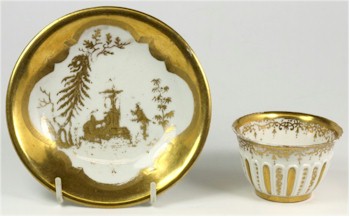
A tea bowl and saucer gilded by the Goldsmiths of Augsburg, circa 1720.
I am sure many people are aware of the historical role of the alchemist as part-scientist
and part-wizard. They were often perceived as in league with 'unholy' forces as
they strove for the philosopher's stone, the means by which they could turn base
metal into gold.
Johann Friedrich Bottger, a gifted chemist, was one such individual but having publically
demonstrated his 'gold making' talents on several occasions the news travelled like
wild fire. The upshot was the earnest and unwelcome attentions from both the Prussian
and German monarchs; the latter eventually 'caught' him and demanded a personal
demonstration upon pain of death.
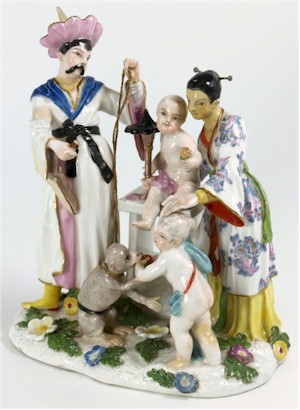
A Meissen figure of a 'typical' Chinese family.
His sleight of hand was uncovered and he was a very real candidate for execution.
However, fortuitously for Bottger, the King had two loves gold and Chinese porcelain.
In an act of tolerance the King chose instead to imprison the young Bottger until
he 'discovered' the secret of making porcelain – it 'only' took six years but in
1708, if you excuse the pun, he struck gold and managed to create the first European
porcelain and the Meissen Porcelain manufactory was born.
Today we are all familiar with porcelain but over three hundred years ago it was
a truly desirable and miraculous substance (especially in comparison to domestic
pottery) and there was not a European monarch that didn't have or desire a collection
of it. During the first few decades of the 18th century its production was kept
a profitable secret by both the Chinese and Meissen. Not surprisingly it was the
mid 1740s before any successful porcelain production occurred on these shores.
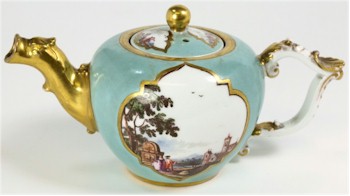
A Meissen teapot circa 1740.
During the 1720s production focussed primarily on tea and breakfast sets and was
in the main quite plain, but did flaunt its rare and luxury credentials by the ostentatious
application of gold and latterly with brightly coloured grounds. The King longed
for larger decorative pieces such as the vases and jars he could get from China
but during this early experimental phase Meissen's craftsmen were unable to pot
and fire such large pieces without disastrous results.
An artistic compromise was reached when they took on a sculptor and were able to
produce figures – something that had not as yet come out of China in any great numbers.
Popular subject matter included Orientals and other exotic races that to modern
eyes look like they were made by someone who had never seen a foreigner in the flesh,
but had instead relied on some rather dubious book illustrations. Other subject
matter was more home grown and included Italian Comedy, classically inspired groups,
artisans, gardeners and a whole menagerie of animals and birds.
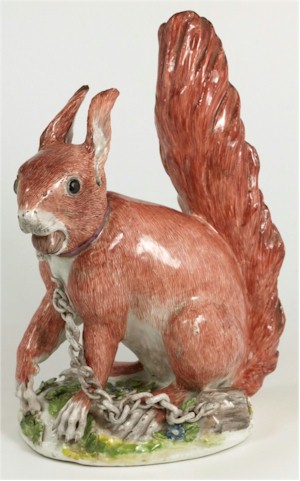
A wonderfully realistic pet squirrel.
Three hundred years on porcelain is produced in every corner of the globe from the
cheapest mass produced wares for daily consumption to the ornate and decorative
pieces that are treasured by their owners. Although there is plenty of competition
Meissen has never dropped its high standards or lost its position as the foremost
producer of fine porcelain.
On the 12th July 2012, Bearnes Hampton & Littlewood are pleased to be offering
a collection of twenty pieces from the Meissen factory dating from the 1720s up
till the early 20th century with estimates up to £10,000-£15,000. So perhaps ironically
it seems that Bottger was successful in producing gold after all!
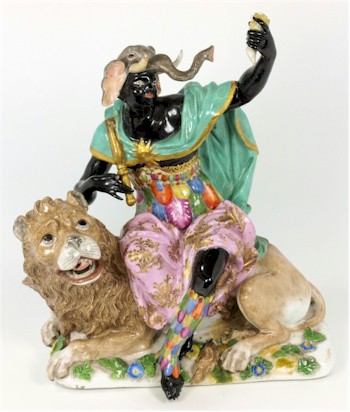
The Meissen idea of a rather overdressed African.
- Bearnes Hampton & Littlewood
- Fine Sale
- Meissen Porcelain
- Johann Friedrich Bottger
- Fine Ceramics









